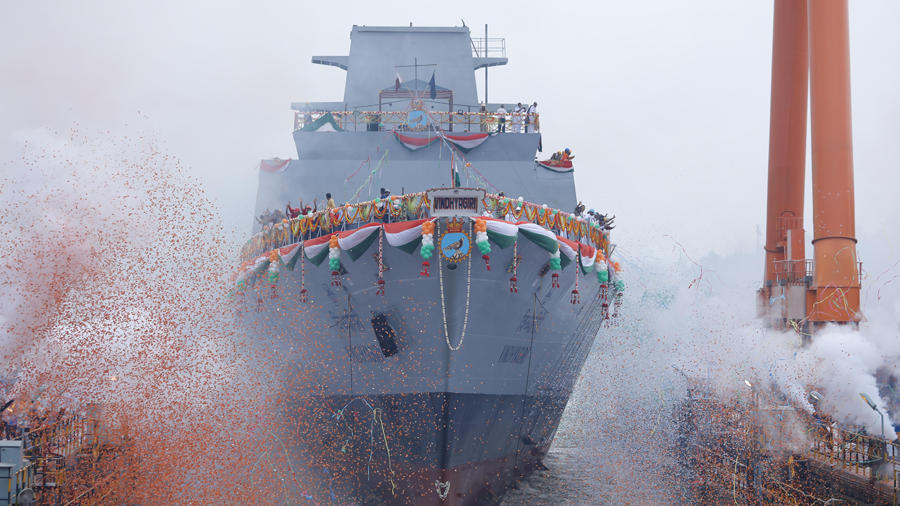
India’s Cabinet approval of a ₹69,725 crore shipbuilding package represents more than sectoral investment. It is a strategic pivot toward economic sovereignty. This massive commitment, nearly tripled from February’s modest $3 billion allocation, signals recognition of a critical vulnerability: India haemorrhages ₹6 lakh crore annually to foreign shipping companies, matching our defence budget.
The scale of dependency is staggering. With 90-95% of India’s cargo controlled by foreign lines, we have surrendered freight pricing power and supply chain autonomy. This is not merely an economic inefficiency but a strategic weakness. Recent Red Sea disruptions and doubled shipping costs to Europe underscore how external dependencies can strangle growth overnight. When global shipping routes face geopolitical tensions, nations without domestic maritime capacity become hostages to external circumstances.
Maritime transport handles 95% of India’s trade by volume and 70% by value, making domestic capacity essential for national security. Yet India controls merely 0.77% of global fleet numbers against 1.2% by capacity, woefully inadequate for an economy transitioning from $4 trillion toward $30 trillion by India’s centenary year of independence. This disparity between India’s economic weight and maritime presence reveals the magnitude of untapped potential.
The comprehensive package introduces a methodical four-pillar approach designed to address systemic weaknesses. The first pillar focuses on strengthening domestic capacity through enhanced financing mechanisms. The second pillar promotes both greenfield and brownfield shipyard development, creating manufacturing clusters that can achieve economies of scale. The third pillar emphasises technical capabilities and workforce skilling through dedicated institutions like the India Ship Technology Centre under the Indian Maritime University. The fourth pillar implements crucial legal, taxation, and policy reforms to create a competitive regulatory environment.
The opportunity is transformative. Asia-Pacific’s maritime dominance, with China holding 70% of global shipbuilding and order books full until 2028, creates space for India’s strategic entry. However, China’s success stemmed from decades of coordinated state intervention, integrated supply chains, and sustained technological investment. India’s approach must be equally comprehensive to compete effectively.
The ₹25,000 crore Maritime Development Fund represents the centrepiece of financial reform. Indian shipbuilders currently face 9-10% interest rates while global competitors access capital at 4-8%. This interest differential makes Indian yards uncompetitive before construction even begins. The Maritime Investment Fund of ₹20,000 crore with 49% government participation, combined with the Interest Incentivisation Fund of ₹5,000 crore, directly addresses this fundamental disadvantage.
Additionally, the extended Shipbuilding Financial Assistance Scheme (SBFAS) until March 2036, with a ₹24,736 crore corpus, provides long-term policy certainty. The inclusion of a ₹4,001 crore Shipbreaking Credit Note supports sustainable practices while creating circular economy opportunities within the sector.
The Shipbuilding Development Scheme (SbDS) with ₹19,989 crore outlay aims to expand domestic capacity to
4.5 million Gross Tonnage annually. This expansion must prioritise high-value segments rather than competing solely on cost. While South Korea dominates LNG carriers with 17% global market share and Japan focuses on specialised vessels, India can carve out distinct niches in emerging maritime technologies.
The establishment of mega shipbuilding clusters will create integrated ecosystems where component manufacturers, technology providers, and skilled workers concentrate geographically. These clusters can achieve the scale efficiencies that make shipbuilding economically viable while fostering innovation through proximity and collaboration.
The package’s employment projections are substantial: nearly 30 lakh jobs across direct shipbuilding and allied industries. Shipbuilding, often called the “mother of heavy engineering,” creates extensive backward and forward linkages. Every shipbuilding job typically generates 3-4 additional jobs in steel, engineering, electronics, and services sectors.
Beyond direct employment, the initiative expects to attract ₹4.5 lakh crore in private investment. This investment multiplier effect occurs because government funding de-risks private capital, encouraging pension funds, insurance companies, and foreign investors to participate in India’s maritime transformation.
Maritime trade routes are lengthening, with average distances rising from 4,944 miles in 2018 to 5,245 miles in 2024 due to geopolitical tensions. Countries with domestic shipping capacity gain strategic autonomy while others face chokepoint vulnerabilities. The Suez Canal blockage and ongoing Red Sea tensions demonstrate how quickly global supply chains can collapse when maritime routes face disruption.
India’s projected trade growth from the current $780 billion toward $2 trillion exports by 2030, combined with rising domestic consumption from 75 million new middle-income households, creates exponential shipping demand. The question is not whether this demand exists but whether Indian shipyards will capture it or continue expensive foreign dependency.
India has already demonstrated its transformative capabilities through strategic intervention. The Production Linked Incentive (PLI) schemes successfully revitalised electronics manufacturing, pharmaceuticals, and textiles, proving how well-designed government support can catalyse private investment and build global competitiveness. Mobile phone production grew from $3 billion to $50 billion within five years under PLI guidance.
The maritime package builds on this proven framework. With competitive financing through the Maritime Development Fund, comprehensive skill development programs, and modern regulatory frameworks like the Indian Ports Act 2025 already streamlining operations, the institutional foundation for transformation exists.
India’s maritime renaissance is already underway. Port turnaround times have halved from 4.67 days in 2014 to
2.04 days in 2024, while cargo handling capacity has doubled to 1.5 billion tonnes annually. The nation now supplies over three lakh trained seafarers globally, demonstrating existing human capital strengths that shipbuilding can leverage.
The maritime opportunity is not just awaiting but unfolding. With proven policy frameworks, substantial financial commitment, and growing global recognition of India’s manufacturing capabilities, the nation is positioned toemerge as a maritime powerhouse. The ₹69,725 crore package represents India’s decisive commitment to transforming from maritime dependency toward strategic autonomy and regional leadership in the blue economy.
Leave a Reply